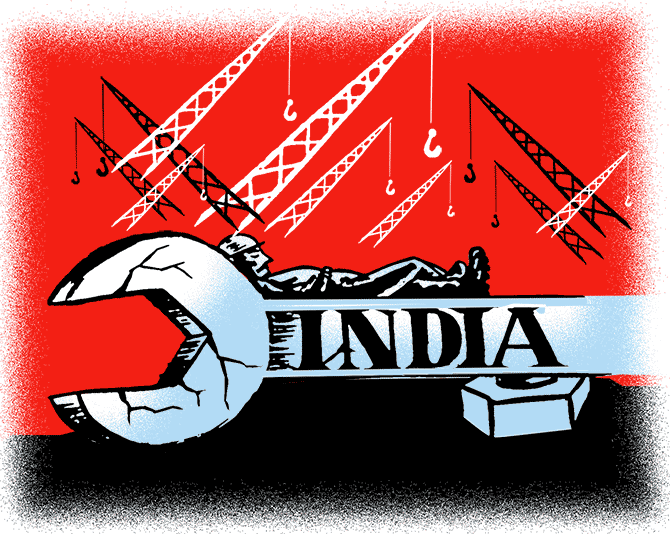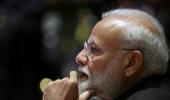'If global growth continues to be sluggish, India instead could potentially take a bigger piece of a shrinking pie,' says Prachi Mishra, managing director, Global Macro Research, and India chief economist, Goldman Sachs.
Illustration: Dominic Xavier/Rediff.com

We often hear that India is a closed economy, and is insulated from global shocks.
Empirical evidence, however, can put both these arguments to rest.
India's trade openness -- defined by the sum of exports and imports to GDP -- has grown at a rapid pace.
Trade as a share of gross domestic product rose from 25% in 2000 to 56% in 2013; the share of exports increased from 11% to 25%, while imports increased from 13% to 31%.
Nevertheless, India did not escape the de-globalisation phenomenon, with exports declining to 19% by 2017, and imports to 21%.
How open is India compared with peers?
While India's trade performance appears to be in line with Indonesia's and possibly better than China's, most of India's Asian peers were far more open during their stages of development at which India currently stands.
We compare India's current trade-to-GDP with that for a larger set of emerging economies at points of time when their per capita incomes were similar to India's current level, at $8,000, in purchasing power parity terms.
We find that India's openness is similar to that of Indonesia, higher than Latin American economies, such as Mexico and Brazil, but lower than ASEAN economies such as Thailand, Malaysia and Vietnam.
The lack of export growth has been a major source of concern for the Indian economy for the last several years.
Export growth declined from an average annual rate of 15% during 2004-2011 to 6% in 2012-2019.
The slowdown in exports could, in fact, explain the entire slowdown in GDP growth over the two time periods.
However, while exports weakened, imports slowed down too.
Real import growth averaged 16% during 2004-2011, compared to 6% during 2012-2019.
Net exports contracted by 1.4% during 2004-2011.
They contracted by less during the slowdown period; therefore, net exports have constituted less of a drag on growth during the slowdown phase.
The growth of Indian exports of goods and services broadly mirrors that of the emerging markets.
More recently, commodity exporters have been hit by lower prices; therefore, Indian exports seem to be doing better.
In particular, since 2016, Indian services exports have shown healthier growth than manufacturing.
Although this is true globally, with structural demand growth for services being robust, Indian services export growth has actually outperformed the average EM in recent years.
If global growth continues to be sluggish, India instead could potentially take a bigger piece of a shrinking pie.
India's share in global merchandise exports has been almost flat at 2% since 2000.
For comparison, China’s share is 12% and has increased from 4% in 2000.
Despite a flat overall share, India's export composition has been transformed -- away from goods toward services; and, within goods, away from textiles toward engineering and electronic goods, transport and chemicals.
Mobile phones are the largest component of domestic electronics production, and their share in electronics production has risen by almost four times since 2015.
Mobile phone exports have increased, while imports have fallen. Notably, Indian electronics exports are not increasing in sophistication or rising up the value chain.
In fact, India is increasingly importing electronic components, assembling mobile phones onshore, and then exporting the final product.
Therefore, the net value addition for mobile phones in India is limited.
This is in contrast with China, for example, which is moving up the value chain, with more of the inputs going into final products, being sourced from inside the country, rather than outside.
A slowdown in trading partners's growth explains 40% of the decline in India's exports over the past year.
Although the role of a global slowdown is important, we find that it is not global demand alone.
A stronger rupee explains about a quarter of the export slowdown, and the rest is explained by domestic factors, which include supply bottlenecks, and the availability of export credit.
The natural question weighing on markets and policymakers's minds is how much longer India's slowdown can last.
For most investors, the duration of the slowdown has been a considerable source of anxiety.
Our baseline scenario suggests that export growth would likely remain close to its current level, by March 2020.
Although weak global macroeconomic conditions and an appreciating rupee lead to a drag on export growth, we see this partly offset by greater availability of export credit as financial conditions ease along with measures to boost export credit.
In recent weeks, the Indian government has rolled out several measures to boost exports, which were rather modest, in our view.
However, a much bolder step was announced on September 20 by the finance minister -- a cut in corporate income tax rates to 22% (from 30% previously) and to 15% for newly incorporated manufacturing firms.
This move makes India’s corporate income tax rates among the lowest in major emerging markets.
While there are clearly other obstacles to expanding the domestic manufacturing sector -- among them land and labour laws -- the policy announcement sends a strong message of intent at a time when many firms are reconsidering their regional supply chains, with the escalation of the US-China trade war.
Overall, to the extent some of these announcements start to filter through the economy, and if these are combined with measures to actively promote special economic zones and free trade agreements, we see a brighter medium-term prospect for India's exports.











